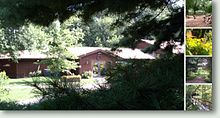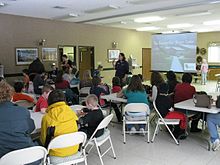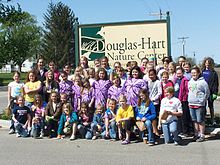- Douglas-Hart Nature Center
-
The Douglas-Hart Nature Center in Mattoon Illinois is a conservancy site that offers visitors Illinois habitats, field programs, eco-educational classes, and volunteer opportunities for all ages.
IN the 1960s, Helen Douglas-Hart made her dream, a 33 acre nature preserve in Coles county, a reality.[1] Today, DHNC provides protection for three of Illinois primary habitats: tall grass prairie, native forest woodlands, and wetlands, on approximately 70 acres. Visitors to the center are welcome to the amenities of DHNC cost-free. Entering the visitor’s center, Guests can view a verity of local wild life exhibits that invite interaction. The center also has a bird observation area outfitted with guides and outdoor audio feed. Guests are free to walk the 2 miles of trails that pass through each local habitat. During each season, DHNC offers individual and family programs and trips that take participants into Illinois habitats to study and engage with the environment. Also, DHNC has many volunteer opportunities which allow guests to be active members in the center’s mission to preserve Illinois ecology and educate the community. For directions to DHNC, follow this link.
Contents
Illinois Habitats
Conservation of the three environmental biotopes native to Illinois is the primary directive of Douglas-Hart Nature Center.[2] The biological communities that compose Illinois tall grass prairies, native forest woodlands, and wetlands are area specific. The plant and animal inhabitants, as well as soil and growth characteristics, are specific to the location and climates of the region. For these reasons, the preservation of these habitats is key to maintaining Illinois’ environment.
Tall Grass Prairies
The native tall grass prairies under protection of DHNC are the most important habitat on the conservancy site. Before widespread settling in Illinois, the Prairie habitat covered 2/3 of the state. Now, prairie grass covers less that 1% of Illinois.[3] Given the rampant destruction of this endangered habitat, both plants and animals that require the conditions of this biotope have decreased exponentially. Some populations of grassland birds, over the last century, have declined by 95%.[4] Figures such as these reiterate the important role conservancies such as DHNC play in maintaining Illinois habitats.[5]
Wetlands
The aquatic habitats found at DHNC consist of natural wetlands. In many cases, wetlands, as we have come to know them, are modified or completely artificial.[6] The wetlands on the conservancy site are made up of the following types:
- Forested Wetland
- Sedge Meadow,
- Surface Pond, and
- Marshland [7]
Each of these aquatic environments is an invaluable habitat that supports various waterfowl, migratory birds, and provides breeding grounds for native species of reptiles and amphibians. These varied wetlands comprise 12 of the 70 acres at DHNC and are equipped with an observation or “lookout” area.[8] However, the wetlands on the conservancy site are in danger. Like many of the natural wetland areas in Illinois, climactic shift is negatively impacting this natural biotope.
Native Forest Woodlands
Native deciduous and coniferous trees comprise the majority of the woodlands at DHNC. According to a survey of the area conducted by The University of Illinois, native trees were present at the site in a 2:1 ratio.[9] Also, the site boosts over 60 species of trees, many native to the state of Illinois.[10] Many of the trees native to the area are labeled for ease of identification by visitors. It is important to note that, even though this biotope is perhaps the best preserved of the three habitats at DHNC, woodlands in Illinois require just as much conservation as the others. Only 12% of the land area in Illinois remains forested compared to 40% before European settling.[11] This represents a nearly 75% decrease in forested area in the state of Illinois alone. Thus, the native forest woodlands are requiring just as much care as the other habitats.
Visitor’s Center
The visitor’s facilities at Douglas-Hart Nature Center offer a number of attractions for all ages and interests. Open seven days a week at no cost to the public, the center is a not-for-profit community based recreational site. Guests to the center are invited to spend time in the bird observation area, read in the library, see the classrooms, interact with sensory displays, play in the child naturalist area, and view live, native animal and plant exhibits. Pamphlets and fliers on events, programs, and conservation are available at the main desk in the lobby. And, for those who want to support DHNC or take home a memento, there is a small gift shop with all proceeds going to support the Douglas-Hart Foundation.
Bird Watching
Located along the north wall of the visitor’s center is a viewing area dedicated to bird and wildlife observation. Guests can sit and observe a number of species of birds (162 different species were recorded in 2008) with outdoor audio and identification materials provided.
Library
The library offers visitors the chance to sit and read environmental books, field guides and other nature material while watching the local wildlife through a large observation window. Audio feed from the outdoor viewing area is available in the Library. Members of DHNC are allowed to check out books, guides, and other materials ranging from texts on habitat conservancy to field guides on wildlife and plant identification.
Classrooms
The classrooms at DHNC can “accommodate up to 100 people” and are used for Educational outreach, Eco-meets, Workshops, and Scouts, as well as a number of community functions.[12]
Children’s Discovery Den
The children’s area at DHNC offers a wide variety of activities for young nature enthusiasts. There is a “camp site,” a few activities tables with drawing supplies and wildlife related toys, a puppet show stage, two interactive nature displays (one based on identifying woodland objects and one involving animal anatomy), and a computer integrated microscope for “specimen” viewing.
Live Animal Exhibits
DHNC offers a number of live animal exhibits for guests to view. The animal exhibits include:
- Green anole, Anolis carolinensis
- Green tree frog, Hyla cinerea
- Painted turtle, Chrysemys picta
- Red-earred slider, Trachemys scripta elegans
- Striped mud turtle, Kinosternon baurii
- Eastern box turtle, Terrapne carolina
- Tiger salamander, Ambystoma tigrinum
- Snapping turtle, Chelydra serpentina
- “Frankie,” the domestic rabbit
- Fox snake, Elaphe vulpina
Each display contains specimens collected locally (except "Frankie"). These live exhibits are maintained within habitatually controlled parameters and lighted during operational hours.
Hiking & Outdoor Recreation
Douglas-Hart Nature Center offers 2 miles of easily accessible, mapped trails to those interested in viewing the conservation site’s habitats. There are five different trails on the property that tender distinct wildlife and biotope observations.
The Trails
The largest trail, the Woodland Loop, traverses all three of the habitats preserved at DHNC. The trail begins in a deciduous woodland area, connects to the south prairie, and provides a walk through the wetland areas of the site. The Thrush Trail and Woodpecker Way both bisect the larger Woodland loop and provide walkers with distinctly different trees and bird watching opportunities. The North Prairie trail, accessible via the Woodland Loop, is the second longest trail and traverses the edge of a Sedge meadow and the large northern prairie habitat. The smallest trail, The White Pine Trail, follows a path through a section of the woodland dominated by the local coniferous species. All of the trails at DHNC are clearly marked, have informational signs posted when entering the different habitats, and have either observation points or benches for nature goers who wish to stop and observe local wildlife.
Picnicking
DHNC has a few picnic areas available to the public. These locations provide tables and waste receptacles so that guests can have lunch while at the site.
Programs and Field Trips
Douglas-Hart Nature Center conducts a number of different programs and field trips during each season of the year which are posted on their event calendar. These activities cater to young and old alike and offer a wide variety of experiences.
Spring
During the spring, DHNC offers a number of activities for children of all ages. These activities are: studies of wetland wildlife, ecosystem interdependence, gardening, spring habitat life cycles, and maple syrup production. All of these Field trips take place on the conservation site and are facilitated by a Naturalist of DHNC.
Fall
During the fall, DHNC offers activities for children and young adults. These programs revolve around studying the transition of the season and its effect on vegetation and an investigation into the natural history and disappearance of the prairie ecosystem. These programs, as well as the spring, are conducted by a Naturalist at DHNC.
Winter
The program during the winter season at DHNC is an activity for all ages. It is based on searching for the signs of wildlife in the snows of winter. Also, this program addresses the questions of animal and habitat survival during the harsh winter months. The winter program is conducted by a Naturalist at DHNC.
Year Round Programs and Trips
DHNC has a number of activities that take place all year long. These activities are tailored for all ages, and teach important lessons about conservation, wildlife, habitat management, plant and animal diversity, bird identification, and the roles of decomposers within an ecosystem. All programs and activities are created to inform the community about Illinois natural environment, how to help and maintain Illinois habitats, and each event is overseen by a DHNC Naturalist.
Publications
Douglas-Hart Nature Center produces its own quarterly news-letter titled, NutHatch News. The goal of the conservancy’s publication is "to bring useful information to the community about DHNC, its programs, services, and staff, as well as helpful and interesting articles about nature and the environment".[13]
Volunteer Opportunities
Being a community, not-for-profit organization, Douglas-Hart Nature Center relies heavily on active participants and volunteers. Volunteers at DHNC accomplish many different tasks for the conservancy site and, without them, the quality or quantity of programs would suffer. But, for those interested in the outdoors, the environment, or maintaining Illinois natural resources, DHNC has a number of opportunities. The following volunteer positions are nearly always available: weekend staff, housekeepers, special events facilitators, newsletter volunteers, youth leaders for children’s programs, natural resource team-members, and front desk assistants.[14] These positions, aside from helping the conservancy and community, can be beneficial to the individual interested in helping manage and maintain vital parts of Illinois environment and habitats.
References
- ^ Condron, Ryan. "Home Page." Doula- Hart Nature Center. Douglas-Hart Nature Center, 2010. Web. 19 Sep 2011. <http://www.dhnature.org/>.
- ^ "Biotope." From Wikipedia, the free encyclopedia. Wikipedia, 27 August 2011 at 16:49. Web. <http://en.wikipedia.org/wiki/Biotopes>.
- ^ “Protecting and Managing Grasslands." Creating Habitats and Homes for Illinois Wildlife. Illinois Department of Natural Resources, n.d. Web. 19 Sep 2011. <http://dnr.state.il.us/orep/pfc/guide/habitats/grasslands/protection.htm>.
- ^ “Protecting and Managing Grasslands." Creating Habitats and Homes for Illinois Wildlife. Illinois Department of Natural Resources, n.d. Web. 19 Sep 2011. <http://dnr.state.il.us/orep/pfc/guide/habitats/grasslands/protection.htm>.
- ^ Robertson, Ken. "Prairie Restoration." The Tallgrass Prairie in Illinois. University of Illinois, n.d. Web. 19 Sep 2011. <http://www.inhs.uiuc.edu/~kenr/prairierestoration.html>.
- ^ What Defines Aquatic Habitat.” Creating Habitats and Homes for Illinois Wildlife. Illinois Department of Natural Resources, n.d. Web. 19 Sep 2011. <http://dnr.state.il.us/orep/pfc/guide/habitats/wetlands/definition.htm>.
- ^ “Wetlands.” From Wikipedia, the free encyclopedia. Wikipedia, 16 September 2011 at 01:09. Web. <http://en.wikipedia.org/wiki/Wetlands>.
- ^ Condron, Ryan. "Home Page." Doula- Hart Nature Center. Douglas-Hart Nature Center, 2010. Web. 19 Sep 2011. <http://www.dhnature.org/>.
- ^ Wang, Jing-Shu, Saeed A. Khan, and Jeffrey O. Dawson. "NITROGEN FIXING TREES INFLUENCE CONCENTRATIONS OF AMMONIUM." AFTA 2005 Conference Proceedings. (2005): 1-17. Web. 19 Sep. 2011. <http://www.cinram.umn.edu/afta2005/pdf/Dawson.PDF>.
- ^ Condron, Ryan. "Home Page." Doula- Hart Nature Center. Douglas-Hart Nature Center, 2010. Web. 19 Sep 2011. <http://www.dhnature.org/>.
- ^ "Illinois Forest Facts." Illinois Forestry. University of Illinois Extention Office, n.d. Web. 19 Sep 2011. <http://web.extension.illinois.edu/forestry/il_forest_facts.html>.
- ^ Condron, Ryan. "Home Page." Doula- Hart Nature Center. Douglas-Hart Nature Center, 2010. Web. 19 Sep 2011. <http://www.dhnature.org/>.
- ^ Condron, Ryan. "Home Page." Doula- Hart Nature Center. Douglas-Hart Nature Center, 2010. Web. 19 Sep 2011. <http://www.dhnature.org/>.
- ^ Condron, Ryan. "Home Page." Doulas-Hart Nature Center. Douglas-Hart Nature Center, 2010. Web. 19 Sep 2011. <http://www.dhnature.org/>.
Works Cited
- "Biotope." From Wikipedia, the free encyclopedia. Wikipedia, 27 August 2011 at 16:49. Web. <http://en.wikipedia.org/wiki/Biotopes>.
- Condron, Ryan. "Home Page." Doulas-Hart Nature Center. Douglas-Hart Nature Center, 2010. Web. 19 Sep 2011. <http://www.dhnature.org/>.
- "Illinois Forest Facts." Illinois Forestry. University of Illinois Extension Office, n.d. Web. 19 Sep 2011. <http://web.extension.illinois.edu/forestry/il_forest_facts.html>.
- “Protecting and Managing Grasslands." Creating Habitats and Homes for Illinois Wildlife. Illinois Department of Natural Resources, n.d. Web. 19 Sep 2011. <http://dnr.state.il.us/orep/pfc/guide/habitats/grasslands/protection.htm>.
- Robertson, Ken. "Prairie Restoration." The Tallgrass Prairie in Illinois. University of Illinois, n.d. Web. 19 Sep 2011. <http://www.inhs.uiuc.edu/~kenr/prairierestoration.html>.
- Wang, Jing-Shu, Saeed A. Khan, and Jeffrey O. Dawson. "NITROGEN FIXING TREES INFLUENCE CONCENTRATIONS OF AMMONIUM." AFTA 2005 Conference Proceedings. (2005): 1-17. Web. 19 Sep. 2011. <http://www.cinram.umn.edu/afta2005/pdf/Dawson.PDF>.
- “Wetlands.” From Wikipedia, the free encyclopedia. Wikipedia, 16 September 2011 at 01:09. Web. <http://en.wikipedia.org/wiki/Wetlands>.
- What Defines Aquatic Habitat.” Creating Habitats and Homes for Illinois Wildlife. Illinois Department of Natural Resources, n.d. Web. 19 Sep 2011. <http://dnr.state.il.us/orep/pfc/guide/habitats/wetlands/definition.htm>.
Categories:- Nature reserves in Illinois
Wikimedia Foundation. 2010.




